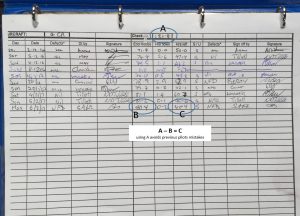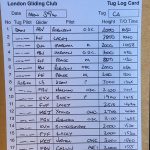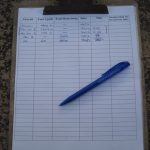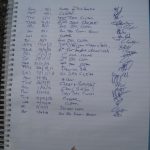Technical Log Tug Status Board Tug Log Cards Fuel Record Fuel Drain Log Pilots Records Booking In/Out Abbreviations
Technical Log
The Tech. Log is an important document as it as it provides a pilot with a current status report on the tug. It also records tug hours and forms a record of defects. The information from the Tech. Log is used by an Aircraft Engineer to schedule maintenance checks and keep the required tug records.
 A Tech. Log entry should be completed for each day’s flying. The line is completed in two stages; After the D.I. the pilot will date and sign for the D.I. At the end of flying, the mags and carb heat should be verified sound before shutting down. Assuming there are no further minor defects, the remaining part of the Tech. Log line is then completed, recording the end ‘Hobbs’ time and calculate the hours remaining, finally signing off. Note the calculation for hours remaining in the example. Once in the hangar, the current hours and time remaining should be updated on the Tug Status board. Should any technical issues arise during the day, then a note should be placed in the Tech. Log, on the Tug Status board and our resident engineer should be informed by phone or email, you can use the Tech Report form for this. If the problem is serious enough to prevent operation then the aircraft must be clearly marked to avoid unintended use, please inform CTP, DCTP or Resident Engineer by phone or text ASAP. Take care before annotating the Tech. Log with “u/s”, doing so will require our engineer to fix the problem and re-establish the aircraft’s serviceability.
A Tech. Log entry should be completed for each day’s flying. The line is completed in two stages; After the D.I. the pilot will date and sign for the D.I. At the end of flying, the mags and carb heat should be verified sound before shutting down. Assuming there are no further minor defects, the remaining part of the Tech. Log line is then completed, recording the end ‘Hobbs’ time and calculate the hours remaining, finally signing off. Note the calculation for hours remaining in the example. Once in the hangar, the current hours and time remaining should be updated on the Tug Status board. Should any technical issues arise during the day, then a note should be placed in the Tech. Log, on the Tug Status board and our resident engineer should be informed by phone or email, you can use the Tech Report form for this. If the problem is serious enough to prevent operation then the aircraft must be clearly marked to avoid unintended use, please inform CTP, DCTP or Resident Engineer by phone or text ASAP. Take care before annotating the Tech. Log with “u/s”, doing so will require our engineer to fix the problem and re-establish the aircraft’s serviceability.
After a 50 hour or annual check a new Tech. Log page will be introduced.
Any queries regarding Tech. Log entries should be made to the Resident Engineer, CTP or DCTP.
Tug Status Board
The Tug Status board in the tug hangar will give the priority order for using tugs and should be adhered to unless there are exceptional circumstances. It will also show if a particular tug is unserviceable or out of check. This information is updated by the Aircraft Engineer or CTP. Tug pilots who find themselves hangaring the aircraft at the end of the day should ensure the Tug Status board is updated with current hours and time remaining plus any new defects or advisories.
Further information maybe found on the ‘Tug Status’ page on the website.
 Tug Log Cards
Tug Log Cards
These record all the information necessary for the office to correctly charge club members for aero-tows.
Before take-off, note on the Tug Log Card the glider, name of the pilot to be charged and take-off time. Subsequently record the exact aero-tow release height (to the nearest 100′). These cards are essential for rendering launch charges to club members and must be legible and accurate. For example, a release at 2100′ should be recorded as such and not 2000′.
At the end of the day the Tug Log Card should be deposited in the Club Office.

Fuel Record
This is kept in the fuel shed and should be completed for all uplifts of fuel. See the ‘Fuel’ page for more information on the installation.
 Fuel Drain Log
Fuel Drain Log
This is kept in a book alongside the fuel record sheet in the fuel hut. It is used for recording water drain checks on the fuel installation. Check that a valid fuel drain check has been recorded for the day before dispensing fuel. Procedure for carrying out a fuel check can be found on the ‘Fuel‘ page.
Pilots Records
Details of pilot’s licence numbers, renewal dates, medicals, hours etc. will be held by the CTP and a summary shown on the ‘Pilot Details’ page. New renewal dates and changes should be advised to the CTP, who in turn will update the online page.
Please note that renewals are strictly the responsibility of individual pilots.
Booking In/Out
It is a legal requirement that all powered aircraft movements not starting and finishing their flights at Dunstable (i.e. most flights other than normal aero-tows) should be recorded. A movement book is located outside the main office, it has two sections, the first for visitors taking details of departure point and destination and a second section for LGC tugs recording either a destination or a departure point.
All aero-tow retrieves, positioning flights or hire flights should be entered along with the pilots signature.
Abbreviations
Here are some abbreviations you can use on Tug Cards and the Tech Log.
| AEI | Air Experience Instructional Flight |
| NFD | No Further Defects (apart from previous entries) |
| NIL | No Defects |
| ODC | One Day Course |
| OWC | One Week Course |
Return to ‘Operations’ Return to ‘Front Page’

